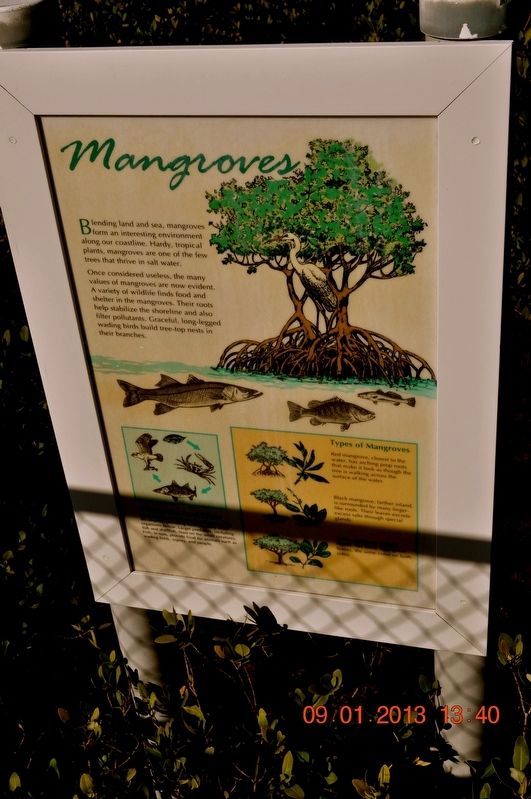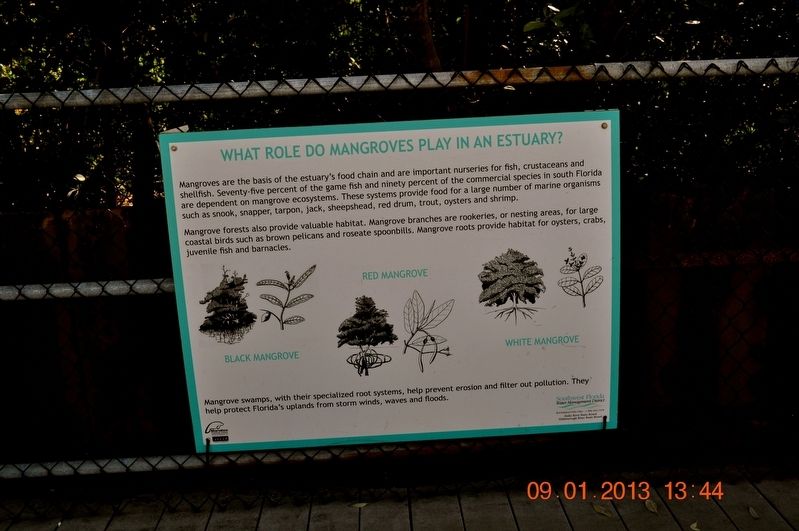Apollo Beach in Hillsborough County, Florida — The American South (South Atlantic)
What Role Do Mangroves Play In An Estuary?
Mangrove forests also provide valuable habitat. Mangrove branches are rookeries, or nesting areas, for large coastal birds such as brown pelicans and roseate spoonbills. Mangrove roots provide habitat for oysters, crabs, juvenile fish and barnacles.
Black Mangrove
Red Mangrove
White Mangrove
Mangrove swamps, with their specialized root systems, help prevent erosion and filter out pollution. They help protect Florida’s uplands from storm winds, waves, and floods.
Southwest Florida
Water Management District
WATERMATTERS.ORG 1-800-423-1476
Alafia River Basin Board
Hillsborough River Basin Board
Topics. This historical marker is listed in these topic lists: Animals • Environment.
Location. 27° 47.557′ N, 82° 24.074′ W. Marker is in Apollo Beach, Florida, in Hillsborough County . Marker is on Dickman Rd. Marker is located inside the park. Touch for map. Marker is at or near this postal address: 6690 Dickman Rd, Apollo Beach FL 33572, United States of America. Touch for directions.
Other nearby markers. At least 8 other markers are within 6 miles of this marker, measured as the crow flies. Storm Water and the Estuary (here, next to this marker); Manatee Scar Identification (here, next to this marker); The Life Cycle of the Monarch Butterfly (here, next to this marker); Long-Legged Wading Birds Stalk the Shallows (here, next to this marker); Listen carefully to hear a manatee! (approx. 0.2 miles away); Do You See a Manatee? (approx. 0.2 miles away); A Butterfly’s Habitat (approx. ¼ mile away); Staking Their Claim (approx. 5.4 miles away). Touch for a list and map of all markers in Apollo Beach.
Also see . . . What are Mangroves?. Worldwide, more than 50 species of mangroves exist. Of the three species found in Florida, the red mangrove (Rhizophora mangle) is probably the most well-known. It typically grows along the water's edge. The red mangrove is easily identified by its tangled, reddish roots called "prop-roots". These roots have earned mangroves the title, "walking trees". This mangrove, in particular, appears to be standing or walking on the surface of the water. (Submitted on August 3, 2017, by Sandra Hughes Tidwell of Killen, Alabama, USA.)

Photographed By Sandra Hughes, January 9, 2013
2. What Role Do Mangroves Play In An Estuary? Marker
Mangroves
Blending land and sea, mangroves form an interesting environment along our coastline. Hardy, tropical plants, mangroves are one of the few trees that thrive in salt water. Once considered useless, the many values of mangroves are now evident. A variety of wildlife finds food and shelter in the mangroves. Their roots help stabilize the shoreline and also filter pollutants. Graceful, long-legged wading birds build tree-top nests in their branches.
Types of Mangroves
Red mangrove, closest to the water, has arching prop roots that make it look as though the tree is walking across the surface of the water.
Black mangrove, farther, inland, is surrounded by many finger-like roots. Their leaves excrete excess salt through special glands.
White mangrove
Has thick, light green leaves, the same color on both sides.
Blending land and sea, mangroves form an interesting environment along our coastline. Hardy, tropical plants, mangroves are one of the few trees that thrive in salt water. Once considered useless, the many values of mangroves are now evident. A variety of wildlife finds food and shelter in the mangroves. Their roots help stabilize the shoreline and also filter pollutants. Graceful, long-legged wading birds build tree-top nests in their branches.
Types of Mangroves
Red mangrove, closest to the water, has arching prop roots that make it look as though the tree is walking across the surface of the water.
Black mangrove, farther, inland, is surrounded by many finger-like roots. Their leaves excrete excess salt through special glands.
White mangrove
Has thick, light green leaves, the same color on both sides.
Credits. This page was last revised on August 7, 2017. It was originally submitted on August 3, 2017, by Sandra Hughes Tidwell of Killen, Alabama, USA. This page has been viewed 202 times since then and 17 times this year. Photos: 1, 2. submitted on August 3, 2017, by Sandra Hughes Tidwell of Killen, Alabama, USA. • Bill Pfingsten was the editor who published this page.
